Native copper
Native copper is an uncombined form of copper that occurs as a natural mineral. Copper is one of the few metallic elements to occur in native form, although it most commonly occurs in oxidized states and mixed with other elements. Native copper was an important ore of copper in historic times and was used by pre-historic peoples.
| Copper | |
|---|---|
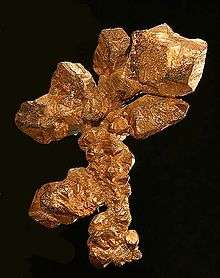 Native copper from Ray mine, Arizona (specimen 5.25 x 4 x 1 cm) | |
| General | |
| Category | Native metal |
| Formula (repeating unit) | Cu |
| Strunz classification | 01.AA.05 |
| Dana classification | 1.1.1.3 |
| Crystal system | Cubic |
| Crystal class | Hexoctahedral (m3m) H-M symbol: (4/m 3 2/m) |
| Space group | Fm3m |
| Unit cell | a = 3.615 Å; Z = 4 |
| Identification | |
| Color | Pale rose on fresh surface, quickly darkens to copper-red; in reflected light, pale rose |
| Crystal habit | As cubes, dodecahedra, and as tetrahexahedra; rarely as octahedra and complex combinations. Commonly flattened on {111}, elongated along [001]. Also as irregular distortions, in twisted, wirelike shapes; filiform, arborescent, massive |
| Twinning | On {111} to produce simple contact and penetration twins and cyclic groups |
| Cleavage | None |
| Fracture | Hackly - jagged |
| Tenacity | Highly malleable and ductile |
| Mohs scale hardness | 2 1⁄2–3 |
| Luster | Metallic |
| Streak | Copper-red |
| Diaphaneity | Opaque |
| Specific gravity | 8.95 |
| Solubility | Soluble in nitric acid |
| Other characteristics | Tarnishes to black or green in air. |
| References | [1][2][3][4] |
Native copper occurs rarely as isometric cubic and octahedral crystals, but more typically as irregular masses and fracture fillings. It has a reddish, orangish, and/or brownish color on fresh surfaces, but typically is weathered and coated with a green tarnish of copper(II) carbonate (also known as patina or verdigris). Its specific gravity is 8.9 and its hardness is 2.5–3.[5]
The mines of the Keweenaw native copper deposits of Upper Michigan were major copper producers in the 19th and early 20th centuries, and are the largest deposits of native copper in the world.[6] Native Americans mined copper on a small scale at this and many other locations,[7] and evidence exists of copper trading routes throughout North America among native peoples, proven by isotopic analysis. The first commercial mines in the Keweenaw Peninsula (which is nicknamed the "Copper Country" and "Copper Island") opened in the 1840s. Isle Royale in western Lake Superior was also a site of many tons of native copper. Some of it was extracted by native peoples, but only one of several commercial attempts at mining turned a profit there.[6] An archived record of native copper originally found up river from Lake Superior, on the west branch of the Ontonagon River, via being dragged by a glacier is seen in the Ontonagon Boulder, Ontonagon Boulder now in the possession of the Department of Mineral Sciences, National Museum of Natural History, Smithsonian Institution.
Another major native copper deposit is in Coro Coro, Bolivia.
The name copper comes from the Greek kyprios, "of Cyprus", the location of copper mines since pre-historic times.[3]
Gallery
- Specimens from notable native copper localities worldwide
 Broken Hill, New South Wales, Australia
Broken Hill, New South Wales, Australia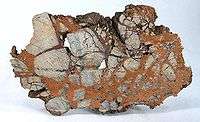 Native copper cementing host rock, Ray Mine, Arizona
Native copper cementing host rock, Ray Mine, Arizona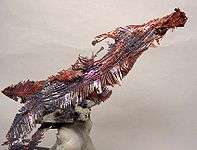 Itauz Mine, Kazakhstan
Itauz Mine, Kazakhstan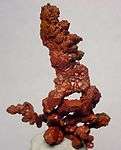 Tsumeb, Namibia
Tsumeb, Namibia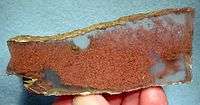 Dendritic native copper encased in transparent gypsum, Mission Mine, Pima County, Arizona, US
Dendritic native copper encased in transparent gypsum, Mission Mine, Pima County, Arizona, US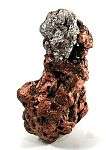 "Halfbreed" copper-silver nugget, Keweenaw County, Michigan, US
"Halfbreed" copper-silver nugget, Keweenaw County, Michigan, US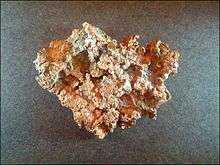
See also
References
- Handbook of Mineralogy
- Copper, WebMineral.com, retrieved 2009-12-04
- Copper, MinDat.org, retrieved 2009-12-04
- Klein, Cornelis and Cornelius S. Hurlbut, Manual of Mineralogy, Wiley, 20th ed., 1985, pp 259-260 ISBN 0-471-80580-7
- "Native Copper". Amethyst Galleries' Mineral Gallery. Archived from the original on 2005-06-28. Retrieved 2005-06-26.
- "Michigan's Copper Deposits and Mining". Archived from the original on 2005-09-09. Retrieved 2005-06-26. (Web archive; click cancel when it asks for authentication.)
- Henry Rowe Schoolcraft and Seth Eastman (1851). Historical and statistical Information, respecting the History, Condition and Prospects of the Indian Tribes of the United States: Coll. and prepared under the direction of the Bureau of Indian Affairs per act of Congress of march 3rd 1847, Volume 1. Lippincott, Grambo. pp. 223–229. Retrieved July 17, 2011.
Further reading
- Thurner, Arthur W. Strangers and Sojourners - A History of Michigan's Keweenaw Peninsula (Detroit, Michigan, U.S.A.: Wayne State University Press, 1994) ISBN 0-8143-2396-0.B
- "Prehistoric Copper in Wisconsin". Mississippi Valley Archaeology Center. Archived from the original on 2005-08-30. Retrieved 2005-06-26.
External links
| Wikimedia Commons has media related to Native copper. |